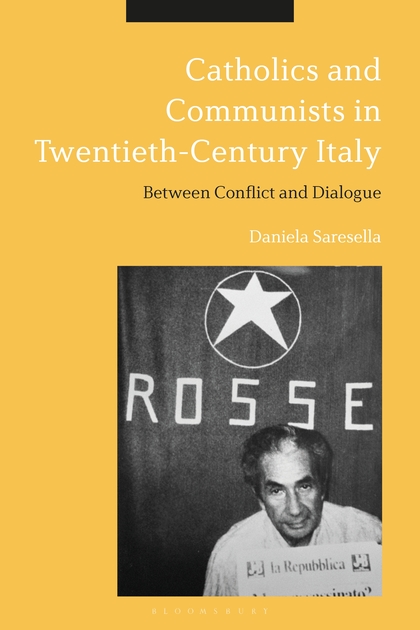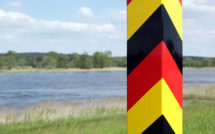
This is part of a roundtable Studying Europe Through the Lens of European Catholicism, and our special feature, Imagining, Thinking, and Teaching Europe.

Daniela Saresella’s Catholics and Communists in Twentieth-Century Italy is a ground-breaking and extremely well-documented book. Although Saresella has published extensively on the subject, this is one of her first volumes in English. It deals with the not sufficiently known subject in European and Transnational Studies: the complex history of the multifaceted relationship connecting Catholics and the Left. The understanding of politics and society in contemporary history has often been marked by a historiographical focus on the political polarization between communism and fascism or, in a larger sense, between forces on the left of the political spectrum, and those occupying the right. As a result, many historians have tended to neglect the complex ideological area existing between the two. This is one of the reasons why the study of progressive Catholicism is significant, as it reveals the historical transcendence of this multilayered zone. In this sense, the book is an important contribution to the ongoing transnational conversation, involving Gerd Rainer Horn, Feliciano Montero García, Marta Margotti and Yvon Tranvouez just to name a few of the main participants.
Organized in seven chapters, and following a chronological perspective, Catholics and Communists in Twentieth-Century Italy pays special attention to the existence of consistencies and legacies over time, along with cases of ambivalence, evolution, discrepancy, and rupture. The book begins by tracing the roots of left-wing Italian Catholicism in the late nineteenth/early twentieth-century (chapter 1). It situates the crucial break between conservative and democratic Catholicism in the French Revolution (8), and reminds us of the particularities of Italian context. What makes Italy unique is the so-called Roman Question (1870-1929), that is, the dispute between the Church and the new unified Italian nation over the redefinition of the role of the Pontiff in the recently created Kingdom of Italy (1861-1946). This context was further influenced by the Non Expedit decree that, since 1868, prevented Catholics from formally participating in political elections; a perspective vigorously defended by the Holy See until the earlier years of the twentieth century.
As the author points out, it was the structural economic and societal changes provoked by industrialization that compelled the Holy See to change its attitude towards the end of the century. This is the local context in which we need to situate Leo XIII’s encyclical Rerum Novarum (1891). Despite the fact that this text partially rejected the program of nineteenth-century socialism, the encyclical was crucial to the development of contemporary Catholicism as it also allied the Church with the modern struggle for social justice. As a result, it opened the way to the establishment of a creative exchange between Catholics and the world of progressive ideas. Should the religious be divided from the political sphere (176)? Could Socialism be Christianized? Or, inversely, could Christianity be socialized? In what ways were the value systems of Christian eschatology and Marxist utopia similar (175)? Could their differences be surmounted? The book reflects the non-linear evolution of this ongoing debate. Precisely, another valuable contribution of Sarasella’s work is to include the perspective of the Left in her study and, in particular, her brief analysis of Antonio Gramsci’s thought on Catholicism should be highlighted as it points out to his well-developed and sophisticated analysis of the religious question and of Christianity’s history (40-47).
The second and third chapters analyze the rise of fascism and its consequences for Italian society. Political violence against socialists and against progressist Catholics led to the silencing of those who were exploring the possibility of establishing contacts between religious and secular anti-fascist forces; many were forced to continue their work from exile, such as, for example, Don Luigi Sturzo, founder of the first Catholic political party the Partito Popolare Italiano(1919). The turning point was marked by the outbreak of the war, and in particular, by the experience of the German occupation. This situation favored an intense collaboration between moderate/progressist Catholics and left-wing parties in the Resistance.
The post-liberation period will bring this alignment to an almost full stop. The outbreak of the Cold War, and the rise of anti-Communism, fostered the opinions of the conservative Curia to a position of relative hegemony in the Church. However, as Saresella shows, a minority of “Christian avant-gardes” maintained a critical stance of this dominant conservative posture (72). This had a great cultural and political significance (79): their experience prepared the way for the gradual radicalization of sections of Catholic public opinion in the wake of Council Vatican II (1962-1965), and for the openness—but also increasing tension and violence—that will characterize Italian political and religious spheres in the sixties and seventies, a subject that is extensively dealt with in chapters 4 and 5.
The arrival of Pope John Paul II, unsympathetic to most innovative tendencies (199), mirrors the greater political context marked by the conservative politics of Ronald Reagan and Margaret Thatcher. The decade was characterized by a general reconsideration of convictions rooted in the previous two decades. However, despite the return to a more conservative ecclesiastical climate, chapter 6 shows the persistence of progressive Catholicism, for example, in the social mobilization for peace as a response to Ronald Reagan’s decision to invest heavily in the arms sector (121); in the rise of volunteer work and non-governmental organizations (122) and in the Church’s condemnation of the high levels of corruption in the Italian political and business system (129). The crisis of the political system in the nineties led to the re-emergence of certain trends, for example, in the founding of the European movement Noi Siamo Chiesa (We are the Church) which, in its defense of the separation between religious and profane spheres, and its grassroots understanding of the faith, referred back to the experience of base ecclesial communities from the seventies (148).[1] It also opened Catholicism to reconsider a number of unsolved issues, such us, the inclusion of the LGBT community and the ordination of women priests.
Without any doubt, one of the strengths of Catholics and Communists in Twentieth-Century Italy is its illustration of the fascinating heterogeneity and intense dynamics that characterize contemporary Italian Catholicism. Notwithstanding a few significant exceptions, history has tended to approach the study of Catholicism as a unified lobbying block. However, as the author carefully shows for the Italian case, the real picture is quite different. There exists a multiplicity of positions, not only within Italy itself, but also within the Catholic world at large, including the Vatican. The book thoroughly follows the particular evolution of these groups through the country’s main historical turning points, including, early twentieth-century Italy, the rise of fascism, the Resistance, post-World War II Reconstruction, the long sixties and seventies, and the turning of the century. In this way, the author introduces the reader to wide range of key figures and participants, as well as to a wide variety of organizations and publications belonging to different Catholic liberal, conservative, moderate and progressist groups. The description of this incredible diversity also involves the crucial portrayal of the complicated relationship existing between laypersons, the local clergy and the Vatican Curia. The book describes the nature of ongoing tensions over their active role within the Church and within contemporary Italian society. Geographical and spatial variation is another fundamental element conveyed by Catholics and Communists in Twentieth-Century Italy. The way Catholics in the countryside and urban areas negotiated their differences, the diversities between Catholics in the North, the Centre and the South of the country, the transcendence of particular regions and relevant centers (such as, Rome, Bologna or Milan) are all well reflected in Saresella’s analysis. In sum, Catholics and Communists in Twentieth-Century Italy illustrates that despite the ongoing processes of secularization, if the Church has managed to consolidate its charismatic position as one of the most recognized institutions in current Italian society and politics, this has been greatly due to the ongoing action of Catholic progressist forces. It also shows the important role played by Catholics in twentieth-century Italian society and the relevance of their legacy for contemporary twenty-first-century Italian politics. This experience should be taken into account when considering the current use of religion by right-wing political agendas.
Natalia Núñez Bargueño received her second Ph.D. in History and Civilisation espagnole from Sorbonne Université(2018). She achieved her first Ph.D. in Spanish Literature from SUNY, Stony Brook (2007). She specializes in the study of contemporary Spanish cultural and transnational history with relation to migration, religion, and Catholicism.
Catholics and Communists in Twentieth-Century Italy: Between Conflict and Dialogue
By Daniella Saresella
Hardcover / 261 pages / 2019
Publisher: Bloomsbury
ISBN: 9781350061422
[1] Base Ecclesial Communities (BEC) are small Christian neighborhood groups that attempt to integrate spiritual and social/material concerns. They were very active in the 60s and the 70s in Latin America, particularly in Brazil during the military dictatorship. Being led by lay-people (that is, not obeying to a hierarchical -i.e. clerical- organization) BEC led to important grassroots-like social practices. This experience strongly influenced European progressist Catholicism.
Published on June 3, 2020.




